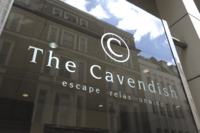The Cavendish Hotel
| The Cavendish London | |
|---|---|
 Location within Central London | |
| General information | |
| Location | 81 Jermyn Street, Mayfair, London, England, United Kingdom |
| Coordinates | 51°30′28″N 0°08′16″W / 51.50778°N 0.13778°WCoordinates: 51°30′28″N 0°08′16″W / 51.50778°N 0.13778°W |
| Technical details | |
| Floor count | 15 |
| Other information | |
| Number of rooms | 230 |
| Number of suites | 6 |
| Number of restaurants | 1 |
| Website | |
| The Cavendish London Official Website | |
The Cavendish Hotel is a modern 4-star, 230-bedroom, luxury hotel in Central London, United Kingdom.[1] It is currently known as "The Cavendish London" and it is owned by Capitaland and operated by The Ascott. It is located on Jermyn Street and has a second entrance on Duke Street. Jermyn Street is traditionally well known for its bespoke gentleman clothing stores, shoe and bootmakers and barber shops.
The hotel gained notoriety in the early and mid 1900s, while under the management of the self-made hotelier, and socialite Rosa Lewis, who was also known as the "Queen of Cooks" and "The Duchess of Jermyn Street".
The Cavendish London was the first hotel in London to receive Gold Grading in the Green Tourism for London Scheme.[2]
The Cavendish London is now owned and managed by the Ascott Limited since the acquisition in the 4th quarter of 2012.
Interior

The hotel features a contemporary style of decoration throughout and the public areas. With 15 floors, the building is substantially higher than most buildings in the area, and the rooms in the higher floors enjoy fine views of the London skyline.
History
There is reference of a hotel operating in the site under the name of "Miller's Hotel" from the early 1800s. However, the hotel was renamed "The Cavendish" in 1836.[3] In 1902, Rosa Lewis bought The Cavendish and put her husband Excelsior Tyrel Chiney Lewis and his sister Laura in charge. By 1904, though, the hotel was not going very well: debts spiralled out of control, Excelsior was having a drinking problem and, therefore, Rosa decided to throw them out and divorce her husband.
Once divorced, Rosa took charge of the hotel and expanded it greatly. The reform meant turning four buildings into one and by then the hotel had over one hundred rooms. During those times, Rosa Lewis cooked regularly for major figures of the times, who were delighted by her cooking and her hospitality. Some of them were the King Edward VII,[4] Lord Northcliffe, General Kitchener and the Duke of Windsor.
During World War I, Rosa Lewis decided to turn The Cavendish into a 'social first aid centre' for servicemen, which she did again for World War II. On 15 May 1941, the hotel was badly damaged by the German air raid. Rosa was in the building at the time, but she was not injured.[5]
Despite the bombing the hotel carried on. In 1944 Rosa Lewis became ill and had to go to a nursing home, leaving her friend Edith Jeffrey in charge of the hotel, which was already showing some signs of decline. She eventually returned to the hotel where Edith took care of her, until she finally died on 28 November 1952 at the age of 85.
For another ten years Edith Jeffrey continued to run the hotel, now in a state of decline, until her own death. In June 1962 the old Cavendish Hotel finally closed its doors. The decision to demolish the old hotel completely was seen as a deeply upsetting act of vandalism by those who had loved it.
The new Cavendish Hotel, completely re-built and bearing no relation at all to its magnificent predecessor, opened its doors in July 1966.
The 1970s BBC series The Duchess of Duke Street was a fictional adaptation with elements taken from the hotel, Rosa Lewis and her husband's story.
References
- ↑ http://www.thecavendish-london.co.uk/about-us
- ↑ http://www.lda.avensc.com/page.asp?id=21
- ↑ Nicholas Redman: The Cavendish Hotel, London, Historical Notes. Self published, 2010, p. 2.
- ↑ TIME Magazine. Requiem for Rosa's. Time, Inc. 29 June 1962.
- ↑ Masters, Anthony. Rosa Lewis, An Exceptional Edwardian. Weidenfeld and Nicholson, 1977, p. 180.